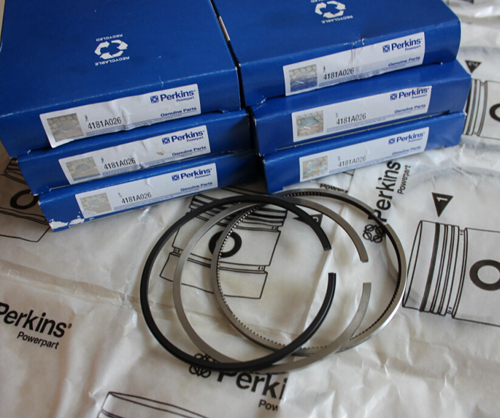详细描述
项目 零配件号码 新件号 描述
1 T415832 6 T415832 活塞及圈装备
(1) T418735 6 T418735 活塞及圈装备 -O/S
(1) T418740 6 T418740 活塞及圈装备 -O/S
6 T406141 6 T406141 连杆组合 坡度: B-蓝
10 T415862 1 T415862 大头轴承装备
(10) T421657 1 T421657 大头 BRG 装备 -U/S
(10) T421658 1 T421658 大头 BRG 装备 -U/S
(10) T421659 1 T421659 大头 BRG 装备 -U/S
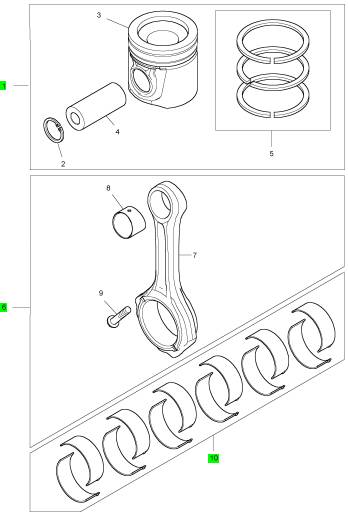
项目 零配件号码 新件号 描述
2 2721332 2 2721332 CIRCLIP
3 1 活塞
4 1 轴头销
5 T409187 1 T409187 活塞环装备
(5) T418420 1 T418420 活塞环装备 -特大号
(5) T418421 1 T418421 活塞环装备 -特大号

项目 零配件号码 新件号 描述
7 1 连杆
8 3112 E031 1 3112 E031 连杆小的一端衬套
9 T400001 2 T400001 连杆螺拴
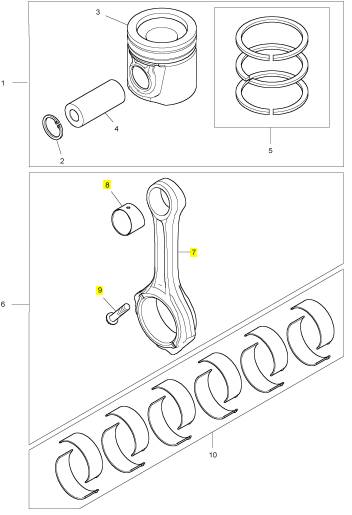
项目 零配件号码 新件号 描述
1 T411539 1 T411539 曲轴
2 T406760 1 T406760 曲轴传动机构
3 0500012 1 0500012 半圆键
4 T409186 1 T409186 推力垫圈装备
(4) T418971 1 T418971 插入垫圈装备 -O/S
5 T411395 1 T411395 圆盘
6 2316 T244 3 2316 T244 螺旋
7 3313 A036 1 3313 A036 合钉
8 T417566 1 T417566 曲轴轴承装备
(8) T417563 1 T417563 曲轴轴承装备 -U/S
(8) T417564 1 T417564 曲轴轴承装备 -U/S
(8) T417567 1 T417567 曲轴轴承装备 -U/S
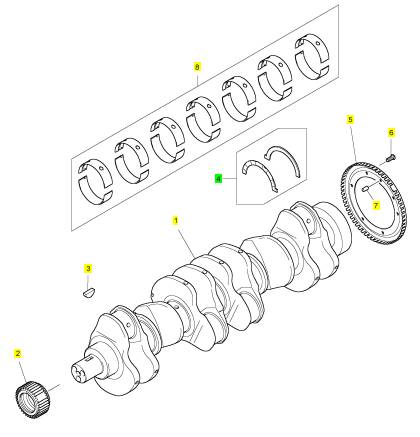
|
Troubleshooting |
|
1206E-E70TTA Industrial Engine |
|
BL (Engine) |
|
This document is printed from SPI². Not for RESALE |
![]()
![]()
![]()
![]()

|
Important Safety Information |
|
Most accidents tha t involve produc t op eration, ma intena nc e and repair are caus ed by failure to ob serve basic safety rules or precautions . An accident can often be avoided by recog nizing pote ntially ha za rdous situations before an accident oc curs . A person mus t be alert to pote ntial ha za rds. This person should also ha ve the ne cessary training, skills and tools to perform the se func tions properly. |
|
Improper operation, lubrication, maintenance or repair of this product can be dangerous and could result in injury or death. |
|
Do not operate or perform any lubrication, maintenance or repair on this product, until you have read and understood the operation, lubrication, maintenance and repair information. |
|
Sa fety precautions and warning s are provided in this ma nua l and on the produc t. If the se ha za rd warning s are not he eded, bod ily injury or death could oc cur to you or to othe r persons . |
|
The ha za rds are identified by the “Safety Alert Symb ol” and followed by a “Signa l Word” suc h as “DANGER”, “WARNING” or “CAUTION”. The Sa fety Alert “WARNING” label is shown below. |
|
The me aning of this safety alert symb ol is as follows: |
|
Attention! Become Alert! Your Safety is Involved. |
|
The me ssage tha t appears und er the warning explains the ha za rd and can be either written or pictorially presente d. |
|
Op erations tha t ma y caus e produc t dama ge are identified by “NOTICE” labels on the produc t and in this pub lication. |
|
Perkins cannot anticipate every possible circumstance that might involve a potential hazard. The warnings in this publication and on the product are, therefore, not all inclusive. If a tool, procedure, work method or operating technique that is not specifically recommended by Perkins is used, you must satisfy yourself that it is safe for you and for others. You should also ensure that the product will not be damaged or be made unsafe by the operation, lubrication, maintenance or repair procedures that you choose. |
|
The informa tion, specifications , and illustrations in this pub lication are on the basis of informa tion tha t was available at the time tha t the pub lication was written. The specifications , torque s, pressure s, me asure me nts , adjustme nts , illustrations , and othe r items can cha ng e at any time. These cha ng es can affect the service tha t is given to the produc t. Ob tain the comp lete and mos t current informa tion before you start any job. Pe rkins dealers or Pe rkins distributors ha ve the mos t current informa tion available. |
|
When replacement parts are required for this product Perkins recommends using Perkins replacement parts. Failure to heed this warning can lead to prema- ture failures, product damage, personal injury or death. |
|
This document is printed from SPI². Not for RESALE |
![]()
![]()
|
KENR9101 |
|
3 |
|
Table of Contents |
|
Table of Contents |
|
Cylinder Is Noisy....................... ...................... 93 Diesel Particulate Filter Collects Excessive |
|
Soot ............................... ............................... 94 Diesel Particulate Filter Has High Ash Load.. . 97 Diesel Particulate Filter Has High Inlet Pressure ............................ ........................... 97 Diesel Particulate Filter Has Low Inlet Pressure ............................ ........................... 99 Diesel Particulate Filter Requires Initial Regeneration ....................... ....................... 100 Diesel Particulate Filter Temperature Is High 101 Diesel Particulate Filter Temperature Is Low 102 ECM Does Not Communicate with Other |
|
TroubleshootingSection |
|
Electronic Troubleshooting |
|
Welding Precaution ..................... ..................... 5 System Overview....................... ....................... 5 Glossary .............................. ............................. 9 Electronic Service Tools ................. ................ 13 Indicator Lamps....................... ....................... 15 Replacing the ECM..................... .................... 20 Self-Diagnostics....................... ....................... 21 Sensors and Electrical Connectors ........ ........ 21 Engine Wiring Information............... ............... 26 ECM Harness Connector Terminals........ ....... 33 |
|
Modules........................... ........................... 103 ECM Will Not Accept Factory Passwords... .. 104 Electronic Service Tool Does Not |
|
Communicate....................... ....................... 104 Engine Cranks but Does Not Start........ ........ 105 Engine Does Not Crank................ ................ 109 Engine Has Early Wear ................ ................ 109 Engine Has Mechanical Noise (Knock).... .....110 Engine Misfires, Runs Rough or Is Unstable. 111 Engine Overspeeds................... ....................115 Engine Shutdown Occurs Intermittently.... ....116 Engine Speed Does Not Change ......... .........117 Engine Stalls at Low RPM.............. ...............118 Engine Top Speed Is Not Obtained....... ....... 120 Engine Vibration Is Excessive........... ........... 124 Exhaust Has Excessive Black Smoke..... ..... 125 Exhaust Has Excessive White Smoke .... ..... 128 Fuel Consumption Is Excessive .......... ......... 130 Fuel Contains Water................... .................. 132 Fuel Rail Pressure Problem............. ............. 133 Fuel Temperature Is High ............... .............. 140 Inlet Air Is Restricted................... .................. 141 Inlet Air Temperature Is High ............ ............ 141 Intake Manifold Air Pressure Is High ...... ...... 142 Intake Manifold Air Pressure Is Low....... ...... 143 Intake Manifold Air Temperature Is High.... ... 145 NRS Exhaust Gas Temperature Is High.... ... 146 NRS Mass Flow Rate Problem........... .......... 149 Oil Consumption Is Excessive........... ........... 151 Oil Contains Coolant................... .................. 153 Oil Contains Fuel..................... ..................... 153 Oil Pressure Is Low.................... ................... 154 Power Is IntermittentlyLow or Power Cutout Is Intermittent......................... ......................... 157 Valve Lash Is Excessive................ ............... 161 |
|
Programming Parameters |
|
Programming Parameters ............... ............... 34 Test ECM Mode....................... ....................... 34 Factory Passwords..................... .................... 34 Flash Programming.................... .................... 35 Injector Code - Calibrate................. ................ 36 Mode Switch Setup..................... .................... 37 Throttle Setup......................... ........................ 38 Multiposition Switch Setup............... ............... 41 |
|
Customer Specified Parameters |
|
Customer Specified Parameters........... .......... 42 Customer Specified Parameters Table...... ..... 49 Customer Specified Parameters Worksheet . . 54 |
|
System ConfigurationParameters System Configuration Parameters......... ......... 58 |
|
Symptom Troubleshooting |
|
Acceleration Is Poor or Throttle Response Is Poor ............................... ............................... 59 Alternator Is Noisy ..................... ..................... 63 Alternator Problem..................... ..................... 64 ARD Combustion Supply Air Pressure Is Low 64 ARD Failed to Ignite.................... .................... 66 ARD Is Disabled ....................... ...................... 72 ARD Loss of Combustion................ ............... 73 ARD Pilot Fuel Pressure Is High........... .......... 76 ARD Pilot Fuel Pressure Is Low ........... .......... 81 ARD Temperature Is Low................ ................ 84 Battery Problem....................... ....................... 88 Coolant Contains Oil.................... ................... 88 Coolant Level Is Low ................... ................... 89 Coolant Temperature Is High............. ............. 90 |
|
Troubleshootingwith a Diagnostic Code Diagnostic Trouble Codes .............. .............. 162 |
|
This document is printed from SPI². Not for RESALE |
![]()
|
4 |
|
KENR9101 |
|
Table of Contents |
|
Diagnostic Code Cross Reference........ ....... 170 No Diagnostic Codes Detected .......... .......... 176 |
|
Troubleshootingwith an Event Code Event Codes......................... ........................ 177 |
|
Diagnostic Functional Tests |
|
5 Volt Sensor Supply Circuit - Test ................ 179 Analog Throttle Position Sensor Circuit - Test189 ARD Fuel Supply - Test ................ ................ 194 ARD Ignition - Test.................... .................... 201 ARD Nozzle - Test .................... .................... 216 ARD Nozzle Heater - Test............... .............. 219 CAN Data Link Circuit - Test............. ............ 236 Data Link Circuit - Test................. ................. 240 Diesel Particulate Filter Identification Signal - Test ............................... .............................. 246 Digital Throttle Position Sensor Circuit - Test 252 ECM Memory - Test................... ................... 261 Electrical Connectors - Inspect........... .......... 261 Engine Pressure Sensor Open or Short Circuit - Test ............................... .............................. 266 Engine Speed/Timing Sensor Circuit - Test. . 279 Engine Temperature Sensor Open or Short |
|
Circuit - Test........................ ........................ 286 Engine Temperature Sensor Open or Short |
|
Circuit - Test........................ ........................ 293 Ether Starting Aid - Test................ ................ 301 Fuel Pump Relay Circuit - Test ........... .......... 305 Glow Plug Starting Aid - Test............ ............ 313 Idle Validation Switch Circuit - Test........ ....... 319 Ignition Keyswitch Circuit and Battery Supply Circuit - Test........................ ........................ 325 Indicator Lamp Circuit - Test............. ............ 332 Injector Data Incorrect - Test............. ............ 335 Injector Solenoid Circuit - Test........... ........... 337 Mode Selection Circuit - Test............ ............ 343 Motorized Valve - Test ................. ................. 347 PTO Switch Circuit - Test............... ............... 355 Sensor Calibration Required - Test........ ....... 358 Solenoid Valve - Test.................. .................. 361 Soot Sensor - Test .................... .................... 370 Throttle Switch Circuit - Test............. ............ 374 Valve Position Sensor - Test............. ............ 378 Water In Fuel Sensor - Test ............. ............. 389 |
|
Index Section |
|
Index............................... .............................. 394 |
|
This document is printed from SPI². Not for RESALE |
![]()
|
KENR9101 |
|
5 |
|
Electronic Troubleshooting |
|
TroubleshootingSection |
|
Electronic Troubleshooting |
|
i04029202 |
|
Welding Precaution |
|
Correct welding procedures are necessary in order to avoid damage to the following components: |
|
• Electronic Control Module (ECM) on the engine • Clean Emissions Module (CEM) • Sensors |
|
Illustration 1 |
|
g01143634 |
|
• Associated components |
|
Service welding guide (typical diagram) |
|
Components for the driven equipment should also be considered. When possible, remove the component that requires welding. When welding on an engine that is equipped with an ECM and removal of the component is not possible, the following procedure must be followed. This procedure minimizes the risk to the electronic components. |
|
5. When possible, connect the ground clamp for the welding equipment directly to the engine |
|
component that will be welded. Place the clamp as close as possible to the weld. Close positioning reduces the risk of welding current damage to the engine bearings, to the electrical components, and to other components. |
|
1. Stop the engine. Remove the electrical power from |
|
the ECM. |
|
6. Protect the wiring harnesses from welding debris |
|
2. Ensure that the fuel supply to the engine is turned |
|
and/or from welding spatter. |
|
off. |
|
7. Use standard welding procedures to weld the materials together. |
|
3. Disconnect the negative battery cable from the battery. If a battery disconnect switch is installed, open the switch. |
|
i03769809 |
|
4. Disconnect all electronic components from the wiring harnesses. Include the following components: |
|
System Overview |
|
• Electronic components for the driven equipment |
|
The engine has an electronic control system. The system controls the engine and the Aftertreatment Regeneration Device (ARD). The system monitors the Diesel Particulate Filter (DPF). |
|
• ECM |
|
• Sensors |
|
The control system consists of the following components: |
|
• Electronically controlled valves • Relays |
|
• Electronic Control Module (ECM) • Software (flash file) • Wiring |
|
• Aftertreatment ID module |
|
NOTICE |
|
• Sensors |
|
Do not use electrical components (ECM or ECM sen- sors) or electronic component grounding points for grounding the welder. |
|
• Actuators |
|
This document is printed from SPI². Not for RESALE |
![]()
![]()
![]()
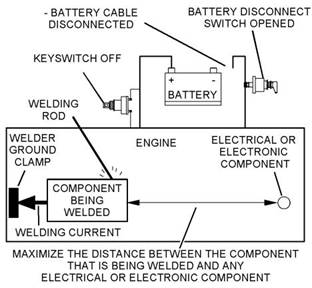
![]()
![]()
|
6 |
|
KENR9101 |
|
Electronic Troubleshooting |
|
The following information provides a general description of the control system. Refer to Systems Operation, Testing, and Adjusting for detailed information about the control system. |
|
Electronic Control Circuit Diagram |
|
Illustration 2 |
|
g02228013 |
|
Electronic control circuit diagram |
|
This document is printed from SPI². Not for RESALE |
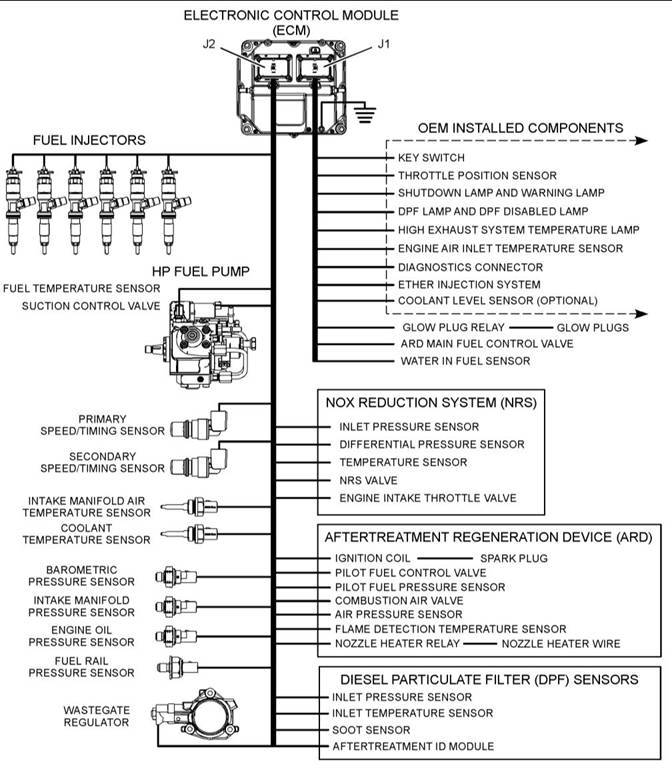
![]()
![]()
|
KENR9101 |
|
7 |
|
Electronic Troubleshooting |
|
Block Diagram |
|
Illustration 3 is a block diagram of the control system. |
|
Illustration 3 |
|
g02356236 |
|
Block diagram |
|
(1) Air cleaner |
|
(17) Soot sensor |
|
(34) Secondary speed/timing sensor |
|
(2) Air inlet temperaturesensor (3) Low-pressure turbocharger (4) Spark plug |
|
(18) ARD heater wire (19) NRS mixer (20) Air-to-airaftercooler (21) ARD body |
|
(35) High-pressurefuel pump/transfer pump/ fuel temperaturesensor (36) Fuel rail pressure sensor (37) Oil pressure sensor |
|
(5) NRS cooler |
|
(6) Ignition coil |
|
(22) Heater relay |
|
(38) Barometric pressure sensor (39) ECM (40) Secondary fuel filter air purge restrictor (41) Fuel transfer pump |
|
(7) Flame detection temperature sensor (8) ARD combustion air valve (9) ARD combustion head (10) Diesel Oxidation Catalyst (DOC) and Diesel Particulate Filter (DPF) (11) High-pressure turbocharger (12) DPF inlet pressure sensor (13) DPF inlet temperaturesensor (14) NRS temperaturesensor (15) NRS valve |
|
(23) Intake throttle valve (24) Wastegate regulator (25) NRS differential pressure sensor (26) Pilot fuel pressure sensor (27) Pilot fuel control valve (28) Engine (29) Coolant temperature sensor (30) ARD fuel pump (31) Primary speed/timing sensor (32) Fuel injectors |
|
(42) Primary fuel filter |
|
(43) Intake manifold pressure sensor (44) Intake manifold air temperature sensor (45) Transfer pump inlet regulator (46) Secondary fuel filter |
|
(47) Fuel tank |
|
(16) NRS inlet pressure sensor |
|
(33) Return fuel cooler |
|
System Operation |
|
The governor uses the throttle position sensor to determine the desired engine speed. The governor compares the desired engine speed to the actual engine speed. The actual engine speed is determined through interpretation of the signals that are received by the ECM from the engine speed/timing sensors. If the desired engine speed is greater than the actual engine speed, the governor injects more fuel in order to increase engine speed. |
|
Engine Governor |
|
The ECM governs the engine. The ECM determines the timing, the injection pressure, and the amount of fuel that is delivered to each cylinder. These factors are based on the actual conditions and on the desired conditions at any given time during starting and operation. |
|
This document is printed from SPI². Not for RESALE |
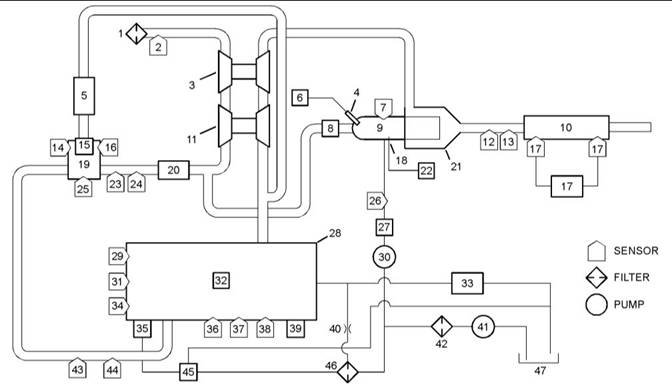
![]()
![]()
|
8 |
|
KENR9101 |
|
Electronic Troubleshooting |
|
• Injection timing • Fuel delivery |
|
The flash file inside the ECM establishes certain limits on the amount of fuel that can be injected. The “FRC Fuel Limit” is a limit that is based on the intake manifold pressure. The “FRC Fuel Limit” is used to control the air/fuel ratio for control of emissions. When the ECM senses a higher intake manifold pressure, the ECM increases the “FRC Fuel Limit” . A higher intake manifold pressure indicates that there is more air in the cylinder. When the ECM increases the “FRC Fuel Limit” , the ECM allows more fuel into the cylinder. |
|
The “Rated Fuel Limit” is a limit that is based on the power rating of the engine and on the engine rpm. The “Rated Fuel Limit” is like the rack stops and the torque spring on a mechanically governed engine. The “Rated Fuel Limit” provides the power curves and the torque curves for a specific engine family and a specific engine rating. All of these limits are determined at the factory. These limits cannot be changed. |
|
Illustration 4 |
|
g01860934 |
|
Typical example |
|
Customer Parameters and Engine Speed Governing |
|
The desired engine speed is typically determined by one of the following conditions: |
|
• The position of the throttle |
|
A unique feature with electronic engines is customer specified parameters. These parameters allow the owner of the machine to fine-tune the ECM for engine operation. Fine-tuning the ECM allows the machine owner to accommodate the typical usage of the machine and the power train of the machine. |
|
• The desired engine speed in Power Take-Off (PTO) |
|
Timing Considerations |
|
Many of the customer parameters provide additional restrictions on the actions that will be performed by the ECM in response to input from the operator. The “PTO Top Engine Limit” is an engine rpm limit that is used by the ECM to limit the fuel during operation of the PTO. The ECM will not fuel the injectors above this rpm. |
|
Once the governor has determined the amount of fuel that is required, the governor must determine the timing of the fuel injection. Fuel injection timing is determined by the ECM after considering input from the following components: |
|
• Coolant temperature sensor |
|
Some parameters are intended to notify the operator of potential engine damage (engine monitoring parameters). Some parameters enhance fuel economy (machine speed, engine speed limit, and idle shutdown). Other parameters are used to enhance the engine installation into the machine. Other parameters are used to provide engine operating information to the owner of the machine. |
|
• Intake manifold air temperature sensor • Intake manifold pressure sensor • Barometric pressure sensor |
|
The ECM adjusts timing for optimum engine |
|
performance and for fuel economy. Actual timing and desired timing cannot be viewed with the electronic service tool. The ECM determines the location of top center of the number one cylinder from the signals that are provided by the engine speed/timing sensors. The ECM determines when injection should occur relative to top center. The ECM then provides the signal to the injector at the desired time. |
|
Other ECM Functions for Performance |
|
The ECM can also provide enhanced control of the engine for machine functions such as controlling the cooling fan. Refer to Troubleshooting, “Customer Specified Parameters” for additional information. |
|
Fuel Injection |
|
ECM Lifetime Totals |
|
The ECM sends a high voltage signal to the injector solenoids in order to energize the solenoids. By controlling the timing and the duration of the high voltage signal, the ECM can control the following aspects of injection: |
|
The ECM maintains total data of the engine for the following parameters: |
|
This document is printed from SPI². Not for RESALE |

 English
English Espaol
Espaol Franais
Franais 阿拉伯
阿拉伯 中文
中文 Deutsch
Deutsch Italiano
Italiano Português
Português 日本
日本 韩国
韩国 български
български hrvatski
hrvatski esky
esky Dansk
Dansk Nederlands
Nederlands suomi
suomi Ελληνικ
Ελληνικ 印度
印度 norsk
norsk Polski
Polski Roman
Roman русский
русский Svenska
Svenska
